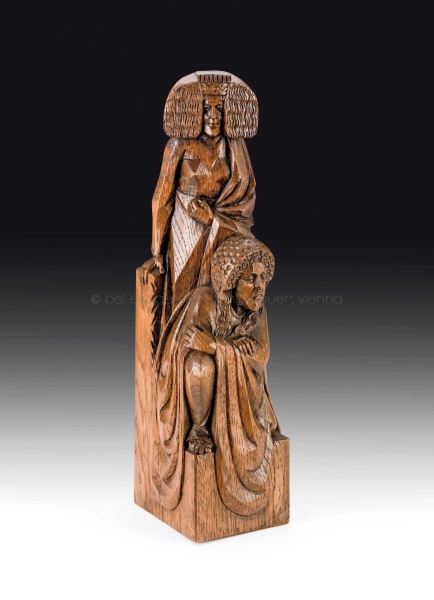Schönau near Neutitschein 1868 – 1931 Vienna
Sculptor, woodcarver, ceramic and porcelain designer
From 1888 to 1897, Barwig studied woodcarving at the Vienna School of Arts and Crafts. From 1890 to 1904, he was active as a self-employed sculptor. 1904/05: teacher at the Technical School of Wood Processing in Villach. 1910–1922: teacher at the Vienna School of Arts and Crafts. 1931: memorial exhibition at the Vienna Secession, exhibition at the Austrian Gallery. Models for the Vienna Augarten porcelain factory and the Wienerberger Brick Works and Construction Company. Many of his works can be found in the Austrian Gallery, Belvedere.
Ref.: Thieme/Becker, Allgemeines Lexikon der bildenden Künstler, vol. 2, p. 587; W. Neuwirth, Wiener Keramik, p. 102; Österreichische Galerie im Oberen Belvedere, 1969, Franz Barwig
Franz Barwig the Elder was born on April 19, 1868 in Senov (Schönau) near Neutischein in Moravia to a family of small farmers.
After self-taught attempts, he first became an apprentice to a carver in his home town, where he worked on sculptures for churches and nativity scenes. Even then, his work enabled him to make an important contribution to the meagre household income. At the age of 20, Barwig finally began his academic studies at the Vienna School of Arts and Crafts in 1888. Initially he studied in the special studio for woodcarving under Wilhelm Hecht, but after a year he switched to Hermann Klotz's specialist class for woodcarving. His eldest son Walter was born in 1899, followed by four more children in 1900, 1901, 1903 and 1906. The young father of the family initially provided a steady income by producing handicrafts and historicist home furnishings. His elaborately designed mirror frames, door panels and church figures are particularly well known from this period, some of which were included in the major annual exhibitions of the Austrian Museum of Art and Industry (now the Museum of Applied Arts/Contemporary Art, Vienna).
In 1900, the Austrian Museum of Art and Industry awarded Barwig a four-week travel grant to the Paris World Exhibition, where he was able to study the latest developments in the field of sculpture. In addition to the work of the top European sculptors such as Rodin, Meunier and Hildebrand, in Paris he also became acquainted with the work of Antoine-Louis Barye, who is regarded as the first important animal sculptor of modern times. It was the four artists mentioned above who were to occupy Barwig's attention in the years to come. Initially, he was particularly impressed by Rodin.
From 1904 to 1906, Barwig received his first teaching assignment at the Technical College for Woodworking in Villach, where he taught nude drawing. In the course of this, he also attended a course held by Franz Ciack at the technical college as a guest student and became friends with him. Through Cizek and Roller's intercession, he was called back to Vienna in 1906, where he initially worked in the teaching materials office at the School of Arts and Crafts until he was offered a professorship. Barwig's task was to produce models for teaching in the technical schools. It was during this time that Barwig began producing his play figures. Among other things, he supplied designs for the cooperative of toy manufacturers in Horice in Bohemia, which were exhibited in the Hagenbund and the Austrian Museum of Art and Industry as well as in the annual toy exhibition at the Baillie Gallery in London and illustrated in the magazine The Studio. Furthermore, Barwig played a decisive role in the decorations for the imperial jubilee procession of 1908.
Barwig worked in the teaching materials office until he was able to lead a course at the School of Arts and Crafts "for the study of large animals" in 1909.
In the fall of 1910, he finally took over one of three specialist sculpture classes. From 1909, he regularly took part in the international exhibitions at the Munich Glaspalast with a large number of works. In 1911 he was represented at the International Art Show in Rome. In 1912, Barwig became a founding member of the Austrian Werkbund and participated in the Werkbund exhibition in Cologne in 1914 with the large fountain figure in the courtyard of honor designed by Oskar Surmad. By the beginning of the First World War, Barwig had established himself internationally as a first-class artist and was at the height of his creative powers.
Towards the end of 1918, Barwig finally fell seriously ill with an infectious disease that is not clearly named in the sources, probably the Spanish flu, which confined him to bed for months and left its mark for the rest of his life.
In 1925, an invitation from his friend Joseph Urban to take on the sculptural decoration of the Mar-a-Lago estate he had planned in Palm Beach, Florida, offered a way out of his financial misery. From January 1926, Barwig worked with his son Walter, first in New York with Urban, then in Florida, on the exuberant decoration of the huge estate, which was planned in Moorish-Spanish style for one of the richest women in the world at the time, Marjorie Hutton (née Merriweather Post).
Another commission came in 1928/29 from Schönbrunn Zoo, where Barwig created two monkey sculptures and two relief tondi for the redesign of the monkeyhouse.
Shortly after recovering from a severe bout of influenza, Franz Barwig committed suicide on May 15, 1931, not far from his villa on the Schafberg in Pötzleinsdorf. In the autumn of 1931, the Secession organized a large memorial show as part of the 119th exhibition, which was also the first solo exhibition of the artist, who had always avoided forcing himself into the foreground of the art scene.
Ref.: comp: M. Fellinger, Franz Barwig the Elder, exhibition catalogue Belvedere Vienna, Vienna, 2014

 THE GODS
THE GODS